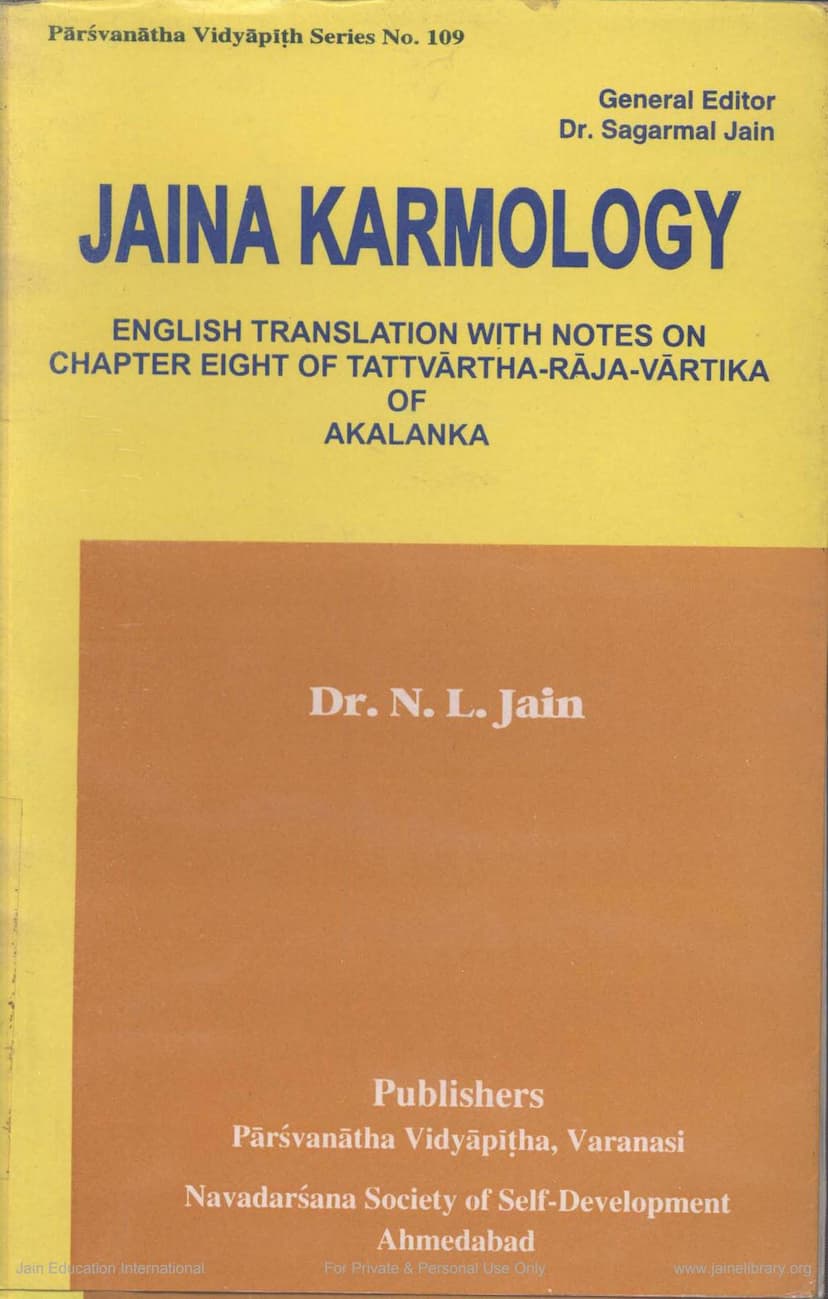Jaina Karmaology
Added to library: September 2, 2025

Summary
Here's a comprehensive summary of the provided Jain text, "Jaina Karmology" by Dr. N. L. Jain:
Overview:
"Jaina Karmology" is an English translation with supplementary notes of Chapter Eight of the Tattvārtha-Rāja-Vārtika, a significant commentary by Bhatta Akalanka on the Tattvārtha-Sūtra of Acārya Umāsvāti. This book focuses on the intricate Jain theory of Karma, considered a cornerstone of Jain philosophy. The author, Dr. N. L. Jain, aims to present this complex doctrine in an accessible manner, incorporating critical evaluations and comparisons with other commentaries and contemporary scientific views.
Key Themes and Structure:
The book delves into the Jaina understanding of Karma, explaining its fundamental principles, classifications, and implications for an individual's life and spiritual journey. The core of the text is the translation and detailed analysis of Chapter Eight of Akalanka's commentary, which systematically covers the following topics:
-
Causes of Karmic Bondage (Aphorisms 8.1-2): This section identifies and explains the five primary causes of karmic bondage: wrong faith (Mithya-darsana), non-abstinence (Virati), non-vigilance (Pramada), passions (Kasaya), and activity (Yoga). It elaborates on the various classifications and sub-classifications of each cause, highlighting their role in attracting and binding karmic particles (karmons) to the soul. The text also includes extensive discussions and refutations of opposing philosophical viewpoints, particularly concerning the nature of the soul, the Vedas, and the concept of violence in religious rituals.
-
Types of Karmic Bondage (Aphorism 8.3): This section details the four primary types of karmic bondage:
- Prakriti (Configuration/Species): The inherent nature or function of the karma (e.g., knowledge-obscuring, feeling-producing).
- Sthiti (Duration): The time period for which the karma remains bonded.
- Anubhava (Fruitional Intensity): The intensity or power with which the karma ripens and produces its effects.
- Pradesa (Mass Point/Space Point): The quantitative aspect, representing the number of fine mattergic particles attracted and bound to the soul.
-
Primary Species of Karma (Aphorism 8.4): The text outlines the eight principal species of karmas:
- Knowledge-obscuring (Jnana-avarana)
- Conation-obscuring (Darsana-avarana)
- Feeling-producing (Vedaniya)
- Deluding (Mohaniya)
- Life-span determining (Ayuh)
- Physique-making (Nama)
- Status-determining (Gotra)
- Obstructive (Antaraya) The commentary provides definitions, justifications for their order, and discussions on their interrelationships and scientific parallels.
-
Secondary Species of Karma (Aphorism 8.5): This section details the numerous sub-species (secondary and tertiary) associated with each of the eight primary karmas, leading to a total count that varies depending on the classification system. The text meticulously lists and defines these sub-species, particularly for the physique-making karma (93 sub-species) and deluding karma (28 sub-species).
-
Detailed Explanation of Primary and Secondary Species (Aphorisms 8.6-8.13): The subsequent aphorisms provide in-depth explanations and definitions for the sub-species of each of the eight primary karmas, including:
- Knowledge-obscuring Karma (8.6): Five sub-species related to sensory, scriptural, clairvoyant, telepathic, and omniscient knowledge.
- Conation-obscuring Karma (8.7): Nine sub-species related to visual, non-visual, clairvoyant, and perfect conation, along with five types of sleep (sleep, deep sleep, drowsiness, deep drowsiness, somnambulism).
- Feeling-producing Karma (8.8): Two sub-species: pleasure-feeling producing and displeasure/pain-feeling producing.
- Deluding Karma (8.9): Categorized into three faith-deluding (righteousness, wrongfulness, mixed) and twenty-five conduct-deluding sub-species (nine quasi-passions and sixteen passions).
- Life-span determining Karma (8.10): Four sub-species based on destinies: hellish, sub-human, human, and celestial.
- Physique-making Karma (8.11): Forty-two sub-species covering aspects like destiny, class, body types, limbs, formation, sensory qualities (touch, taste, smell, color), and unique qualities like fordbuilderness.
- Status-determining Karma (8.12): Two sub-species: high status and low status.
- Obstructive Karma (8.13): Five sub-species: obstructing donation, gains, enjoyments of consumables, non-consummables, and energy/potency.
-
Duration of Karmas (Aphorisms 8.14-8.20): This section details the maximum and minimum durations for various karmic species, providing specific time units like Sagaropama and Muhurta. It highlights that deluding karma generally has the longest duration, while life-span karma has the shortest minimum duration.
-
Fruitional Intensity and Dissociation (Aphorisms 8.21-8.23): The text defines fruition (Anubhava) as the intensity of ripening or maturation of karmas, explaining how it's influenced by volitions and circumstances. It also discusses dissociation (Nirjara), the natural or pre-mature shedding of karmas after fruition, and the role of austerities in this process.
-
Mass Point Bondage (Aphorism 8.24): This aphorism defines mass-point bondage by describing the fine, homogenous, and infinite-times-infinite mattergic particles that are attracted to and pervade the soul due to activities.
-
Merit and Demerit Bonding (Aphorisms 8.25-8.26): The final section distinguishes between merit-earning (Punya) and demerit-earning (Papa) karmic species. It lists the auspicious sub-species contributing to merit (like pleasant feeling-producing, auspicious life-span, physique-making, status-determining karmas) and the remaining demerit-earning species.
Author's Approach and Contributions:
Dr. N. L. Jain's work is characterized by:
- Faithfulness to the Text: Rigorous translation of Akalanka's commentary.
- Critical Evaluation: Incorporating insights from other Jaina commentaries and scholars.
- Modern Scientific Correlation: Drawing parallels between Jaina concepts and contemporary scientific understanding in fields like psychology, physiology, and physics, often in the supplementary notes.
- Clarification of Terminology: Aiming for clarity by using simple and common English terminology, sometimes coining new terms.
- Structured Presentation: A clear five-point serial for commentarial translation, including introductions, aphorisms, import, semi-aphorismic translation, and supplementary notes.
- Emphasis on Practical Application: Connecting the theoretical aspects of Karmology to self-development, stress management, and achieving a tranquil state of mind.
Significance:
"Jaina Karmology" serves as a vital bridge between ancient Jain wisdom and modern intellectual inquiry. It makes the profound and complex Jaina theory of Karma accessible to a wider audience, offering a comprehensive framework for understanding the causes and effects of actions and their impact on one's spiritual progress. The book is a valuable resource for scholars, researchers, and anyone seeking a deeper understanding of Jain philosophy and its practical implications for living a virtuous and tranquil life.